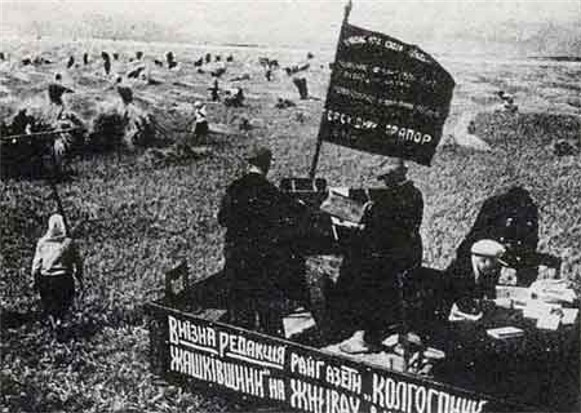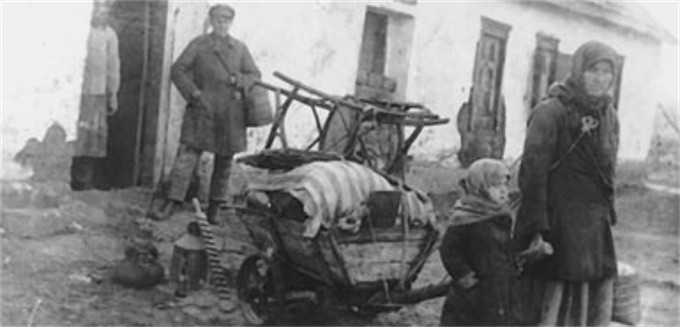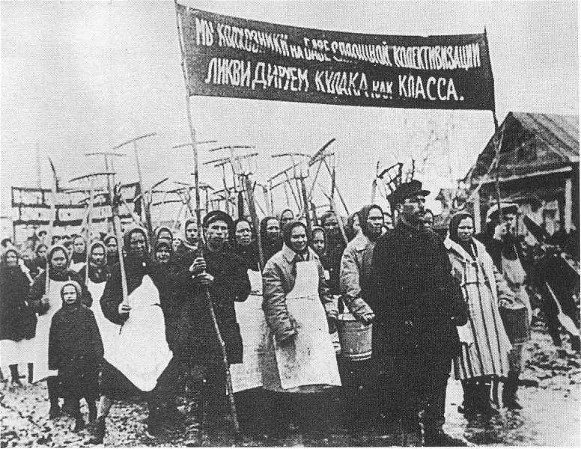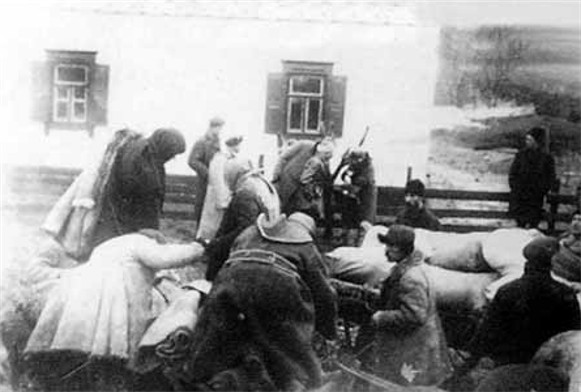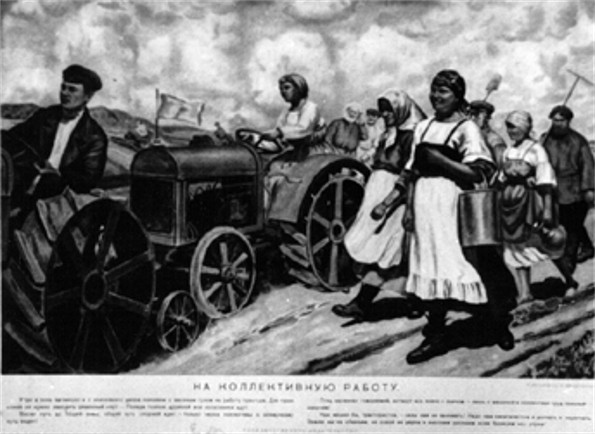Collectivization
Collectivization (колективізація; kolektyvizatsiia). In Soviet terminology the transformation of agriculture from private-capitalist to collective-socialist production. The idea of collectivization has long been familiar in socialist co-operative movements, and Marxists have inserted it into their program. According to F. Engels, the process of collectivization must be completely voluntary and gradual. The Communists in Russia adopted a program of collectivization only after the October Revolution of 1917. In the USSR the long-term aim of collectivization was to set up large, state-owned, mechanized farms managed by experts and utilizing the newest inventions of science and technology. The short-term aim was to establish a form of collective farming that would provide the state with the maximum production of agricultural goods at a minimum level of peasant consumption.
Before the collectivization drive at the end of the 1920s the prevailing view was that this transformation was to take place voluntarily. Basically, three types of collective farms were set up: (1) associations for the joint cultivation of land (TSOZ), without socialized means of production; (2) the agricultural artels, which were co-operatives with socialized means of production but with privately owned farms; and (3) communes, in which all the means of production were socialized, the land was worked collectively, and consumption and way of life were communal. These types of associations were voluntary, that is, the admission of members was based on a civil-law contract that provided for voluntary withdrawal. The peasants preferred the first form of collective farming because it guaranteed that the means of production would remain privately owned.
The first collective farms, which were communes consisting mostly of workers, appeared in the Ukrainian SSR as early as 1919. In February 1921 the first congress of farm collectives took place in Odesa. The decree of the All-Ukrainian Central Executive Committee of 9 August 1922 encouraged voluntary collectivization by various incentives. Vladimir Lenin's ‘co-operative plan’ provided for a gradual collectivization through the development of all the forms of co-operative association, particularly of co-operative machine associations, which would give the peasants an economic incentive to work their land jointly. Ukrainian agrarian co-operative organizers such as I. Klymenko, M. Odynets, and Oleksa Trylisky contributed to the theory of voluntary collectivization, mainly in the form of the Association for the Joint Cultivation of Land rather than of the artel.
There were 193 voluntary collective farms in 1921 and 9,734 in 1928, embracing 2.5 percent of all farms and 2.9 percent of the land. According to the first version of the First Five-Year Plan for the Ukrainian SSR, 12 percent of all arable land was to be collectivized by 1932. The final version of the plan, which was approved in April 1929, projected 25 percent of the land to be collectivized. In November 1929, however, all these plans were set aside, and forced collectivization was begun.
The All-Union Communist Party (Bolshevik) introduced forced collectivization because there was not enough capital to fulfill the First Five-Year Plan of rapid industrialization. Additional capital could be secured only by increasing exports of farm products, and so large quantities of them had to be purchased at low prices. However, the peasants did not want to surrender their grain to the state at ridiculously low prices. Furthermore, the Great Depression caused the price of grain on the world market to fall. The Soviet government also wanted to deprive the peasants of their own means of production and to draw excess labor resources from the countryside into the cities.
Forced collectivization was approved by a resolution of the Plenum of the Central Committee (CC) of the All-Union Communist Party (Bolshevik) on 17 February 1929, which stated: ‘Ukraine should in the shortest period provide models of the organization of a large nationalized economy.’ The plenum decided to start the building of the Kharkiv Tractor Plant and a combine plant in Zaporizhia. Accordingly, the November Plenum of the CC of the CP(B)U and the government of the Ukrainian SSR decided on 25 December 1929 to collectivize up to 21.6 percent of the land by October 1930. But the resolution of the CC of the All-Union Communist Party (Bolshevik) adopted on 5 January 1930 ordered the collectivization drive to be speeded up and to be completed in the main grain-growing regions in one to two years and ‘the kulaks as a class to be liquidated,’ on the assumption that they would be the leaders of the resistance to collectivization. To fulfill the plan, the CP(B)U sent its cadres into the countryside, increasing their number from 38,500 in 1930 to 112,000 in 1932. It also sent urban industrial workers (10,500 in 1930), who were appointed chairmen of collective farms and rural soviets, and 19,400 urban workers and functionaries on temporary assignment to the villages. As the head of the Soviet Ukrainian government, Vlas Chubar, stated, the collectivization of the middle stratum of peasants was conducted according to the principle ‘join the collective farm or else off to the Solovets Islands’ (ie, exile). Peasants were forced to join collective farms under duress. Economic pressure was also used: individual farmers had to deliver 300–400 poods (5–6.5 t) of grain to the state in 1930, while collective-farm members were exempted from this. The collective-farm members paid a monetary tax of 5–7 percent of their income, while all other peasants were taxed at 7–70 percent.
The rate of collectivization was greatly accelerated. By 10 March 1930, 65 percent of farms and 70 percent of draft animals were collectivized. In many cases everything, including chickens and houseware, was socialized. The use of force provoked uprisings among the peasants, particularly the so-called women's revolts (babski bunty). Joseph Stalin retreated a step and on 2 March 1930 published an article in Pravda (Moscow) entitled ‘Dizziness from Success,’ in which he ordered an end to forced collectivization. As a result, on 15 March 1930 the CC of the All-Union Communist Party (Bolshevik) permitted the peasants to resign from the collective farms and to reclaim their property. In Ukraine almost half of the peasants immediately left the collective farms (see the accompanying table), and by 1 February 1930 only 30 percent of peasant farms remained collectivized. When it became clear that without coercion the collective farms would disintegrate and the peasants would return to individual farming, forced collectivization was reintroduced.
At first the government of the Ukrainian SSR resisted the decisions coming from Moscow about an accelerated, forced collectivization, but in November 1930 it agreed to collectivize 70 percent of the land by the spring of 1931. The December Plenum of the CC of the All-Union Communist Party (Bolshevik) raised the goal to 80 percent and resolved that during 1932 collectivization would have to be completed. Thus, a second collectivization drive was begun in the winter of 1930–1. By 2 August 1931 the CC of the All-Union CP(B) noted that in Ukraine collectivization was reaching completion. The extent of resistance among the Ukrainian peasants can be seen in the official statistics: during 1931 alone arson was reported on 24.7 percent of the new collective farms, poisoning of cattle on 3.8 percent, destruction of machinery on 9.6 percent, and assault on Party activists on 44 percent. Revolts and uprisings broke out in many villages. This resistance did not come from the kulaks, most of whom had been crushed in 1930. The level of resistance is apparent also in the mass slaughter of cattle, intended to keep them from the collective farms. Between 1928 and 1932 the number of cattle in Soviet Ukraine fell from 8.6 million to 4.8 million head.
In 1930 Moscow raised the quota for grain deliveries (see Grain procurement) in Ukraine by 115 percent above the 1926–7 quota. Of the 23.1 million t harvest, 7.7 million t were taken by the state. The same quota was applied to the 1931 harvest, although the collectivization reduced the yield because the collective farms were poorly run and the peasants were unable and unwilling to work collectively. According to official data, the 1931 harvest was 18.3 million t, yet 30–40 percent of it was lost in the harvesting process. Of the actual harvest in 1931 of 11–13 million t, the government succeeded in exacting 7 million t. As a result, an average of only 112 kg of grain per person was left to the Ukrainian peasants to consume, and in the spring of 1932 famine broke out in Ukraine (see Famine-Genocide of 1932–3). In spite of the famine and the poor harvest in 1932 of 13.4–14.7 million t, with losses this time of 40–50 percent during harvesting, Moscow imposed a quota of 6.6 million t. It managed to exact only about 5 million t. As Mykola Skrypnyk stated, ‘there was nothing to take; everything had been swept away already as with a broom.’ As a consequence, the average peasant in Ukraine was left only 83 kg of grain to live on, and the famine was even more severe in 1933. At the same time there was almost no famine in Russia, for the delivery quotas there were considerably lower than in Ukraine. The figures prove that Ukraine was intentionally exploited: its harvest amounted to 27 percent of the USSR harvest, while its delivery quotas amounted to 38 percent.
To prevent the starving peasants from taking grain belonging to collective farms, on 7 August 1932 the government of the USSR issued the law ‘On the Protection of Socialist Property,’ which permitted capital punishment for this kind of crime. Since in 1932 the collectivization drive did not progress and the collective farms were in a pitiful condition, on 3 January 1933 the USSR government published the decree ‘On Strengthening the Collective Farms,’ which permitted authorities to confiscate all the property of the peasants who refused to join collective farms and to exile the peasants to Siberia. At the same time political departments were set up at machine-tractor stations (MTS) and were given full administrative authority in the villages. These departments were staffed mostly by Chekists (see Cheka) and used terror to complete the collectivization drive. The collective farms improved somewhat only when farming began to be rapidly mechanized, beginning in 1933. As late as 1932, 76.2 percent of the energy used for farming in Soviet Ukraine consisted of animal power.
The greatest pressure to collectivize within the USSR took place in Ukraine, the Don region, and the Kuban. In the Russian SFSR collectivization progressed at a slower rate than in Ukraine: 7.4 percent of the peasant farms were collectivized in Russia by 1 October 1929, 59.3 percent by 1 March 1930, 23.4 percent by 1 May 1930, 59.3 percent by 1 July 1932, and 92.6 percent by 1 October 1937.
Because of collectivization, after 1935 the state could buy at bargain prices or seize over 50 percent of the collective-farm production of Ukraine, which it then resold at higher prices in the cities, to the peasants themselves, and abroad. The free capital obtained in this way was used to develop heavy industry (see Agricultural procurement and Collective farm). Because of the collectivization, capital investment in the Soviet Union in 1932 was 5.2 times as high as it had been in 1928. The collectivization also provided industry with a huge labor pool: workers were recruited in a planned way on the collective farms, like military conscripts.
In Western Ukraine collectivization began after the first Soviet occupation in the summer of 1940. By the beginning of 1941 only 3.1 percent of peasant farms were collectivized. By 1 June 1941 as many as 13 percent were. A new, postwar collectivization drive began in the fall of 1948, and the last drive took place in the spring of 1950 as is evident from the statistics: 9.6 percent of farms were collectivized by 1 January 1948, 49 percent by 1 January 1949, and 92.7 percent by 1 July 1950. The Soviets applied the same methods here as they had used in central and eastern Ukraine to force the peasants into the collective farms. Political departments, for example, were set up at machine-tractor stations and were staffed with armed MVD agents. During the collectivization in Western Ukraine, and particularly in Subcarpathia, the Ukrainian Insurgent Army put up a stiff resistance to collectivization. Soviet agents were assassinated, farm buildings were burned down, cattle were slaughtered, and operations were sabotaged. In retaliation large numbers of peasants were deported to Siberia and Central Asia. Most of the collective farms in Western Ukraine remained poor and run-down for a long time.
BIBLIOGRAPHY
Vseukrsoiuz sel'sko-khoziaistvennykh kollektivov. Kolkhoznoe dvizhenie na Ukraine (Kharkiv 1929)
Chubar, V. Do novykh peremoh (Kharkiv 1930)
Demchenko, M. Shliakhy sotsiialistychnoï perebudovy sil's'koho hospodarstva na Ukraïni (Kharkiv 1930)
Iakovlev, Ia. Voprosy organizatsii sotsialisticheskogo sel'skogo khoziaistva v pervoi piatiletke (Moscow 1934)
Kommunisticheskaia Akademiia. Osnovnye direktivy partii i pravitel'stva po khoziaistvennomu stroitel'stvu 1931-1934 gg. (Moscow 1934)
Matsiievych, K. Kolektyvizatsiia selians'koho hospodarstva na Ukraïni. Pratsi Ukraïns'koho naukovoho instytutu, 32 (Warsaw 1936)
Solovij, D. The Golgotha of Ukraine (New York 1953)
The Black Deeds of the Kremlin: A White Book, 1, Book of Testimonies (Toronto 1953)
AN USSR. Ocherki razvitiia narodnogo khoziaistva Ukrainskoi SSR (Moscow 1954)
Timoshenko, V. Soviet Agricultural Policy and the Nationalities Problem in the USSR: Report on the Soviet Union 1956 (New York 1956)
Rozenfel'd, V. Dvadtsatipiatitysiachniki (Moscow 1957)
Chmyga, A. Ocherki po istorii kolkhoznogo dvizheniia na Ukraine 1921–1925 gg. (Moscow 1959)
Istoriia kolektyvizatsiï sil's'koho hospodarstva Ukraïns'koï RSR: Zbirnyk dokumentiv i materialiv, 2 vols (Kyiv 1962–5)
Sotsialistychna perebudova i rozvytok sil's'koho hospodarstva Ukraïns'koï RSR, 2 vols (Kyiv 1967–8)
Lewin, M. Russian Peasants and Soviet Power: A Study of Collectivization (Evanston, Ill 1968)
Chmyga, A. Kolkhoznoe dvizhenie na Ukraine (Moscow 1974)
Davies, R.W. The Industrialization of Soviet Russia, 2 vols (Cambridge, Mass 1980)
Radziejowski, J. ‘Collectivization in Ukraine in Light of Soviet Historiography,' JUS, 5, no. 2 (1980)
Conquest, R. The Harvest of Sorrow: Soviet Collectivization and the Terror–Famine (Edmonton 1986)
Kul’chyts’ky, S. et al (eds); Mykhailychenko, H.; Shatalyna, Ye. (comps). Kolektyvizatsiia i holod na Ukraïni, 1929–1933: Zbirnyk dokumentiv i materialiv (Kyiv 1992)
Graziosi, A. The Great Soviet Peasant War: Bolsheviks and Peasants, 1917–1933 (Cambridge, Mass 1996)
Vasil’ev, V.; Viola, L. Kollektivizatsiia i krest’ianskoe soprotivlenie na Ukraine (noiabr’ 1929–mart 1930 gg./ Kolektyvizatsiia i selians’kyi opir na Ukraïni (lystopad 1929–berezen’ 1930 rr.) (Vinnytsia 1997)
Hrynevych, Liudmyla. Khronika kolektyvyzatsiï ta Holodomoru v Ukraïni, 1927–1933, vol 1, bk 1 (Kyiv 2008)
Graziosi, Andrea. Stalinism, Collectivization and the Great Famine (Cambridge, Mass 2009)
Holodomor Studies 1, no. 1 (2009)
Vsevolod Holubnychy
[This article originally appeared in the Encyclopedia of Ukraine, vol. 1 (1984). The bibliography has been updated.]
